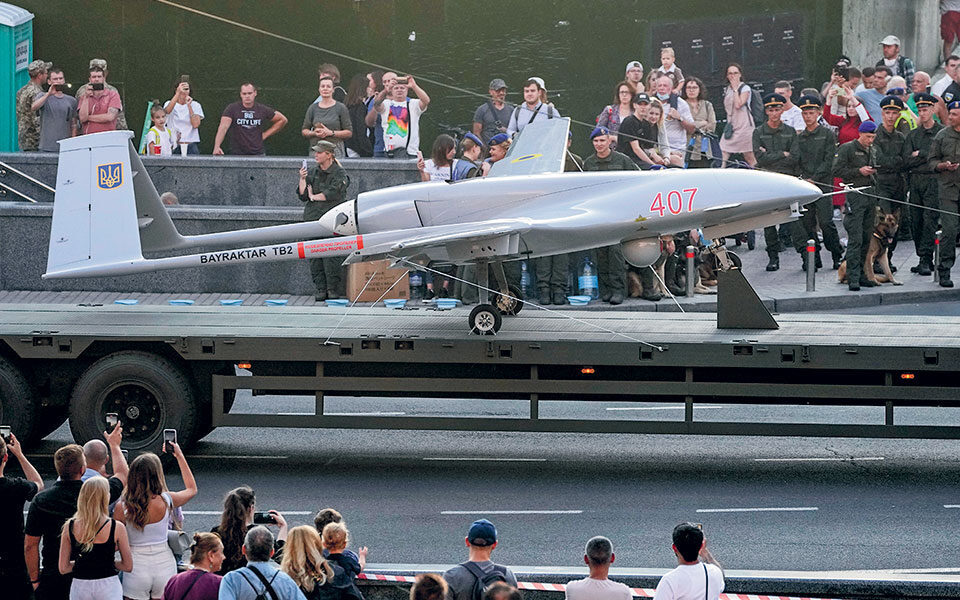A video posted toward the end of February on the Facebook page of Valerii Zaluzhnyi, the commander-in-chief of Ukraine’s armed forces, showed grainy aerial footage of a Russian military convoy approaching the city of Kherson. Russia had invaded Ukraine several days earlier, and Kherson, a shipbuilding hub at the mouth of the Dnieper River, was an important strategic site. At the center of the screen, a targeting system locked onto a vehicle in the middle of the convoy; seconds later, the vehicle exploded, and a tower of burning fuel rose into the sky. “Behold the work of our life-giving Bayraktar!” Zaluzhnyi’s translated caption read. “Welcome to Hell!”
The Bayraktar TB2 is a flat, gray unmanned aerial vehicle (U.A.V.), with angled wings and a rear propeller. It carries laser-guided bombs and is small enough to be carried in a flatbed truck, and costs a fraction of similar American and Israeli drones. Its designer, Selçuk Bayraktar, the son of a Turkish auto-parts entrepreneur, is one of the world’s leading weapons manufacturers. In the defense of Ukraine, Bayraktar has become a legend, the namesake of a baby lemur at the Kyiv zoo, and the subject of a catchy folk song, which claims that his drone “makes ghosts out of Russian bandits.”
In April, 2016, the TB2 scored its first confirmed kill. Since then, it has been sold to at least thirteen countries, bringing the tactic of the precision air strike to the developing world and reversing the course of several wars. In 2020, in the conflict between Azerbaijan and Armenia over the enclave of Nagorno-Karabakh, Azerbaijan’s dictatorial leader, Ilham Aliyev, used the TB2 to target vehicles and troops, then displayed footage of the strikes on digital billboards in the capital city of Baku.
The TB2 has now carried out more than eight hundred strikes, in conflicts from North Africa to the Caucasus. The bombs it carries can adjust their trajectories in midair, and are so accurate that they can be delivered into an infantry trench. Military analysts had previously assumed that slow, low-flying drones would be of little use in conventional combat, but the TB2 can take out the anti-aircraft systems that are designed to destroy it. “This enabled a fairly significant operational revolution in how wars are being fought right now,” Rich Outzen, a former State Department specialist on Turkey, told me. “This probably happens once every thirty or forty years.”
I spoke with Bayraktar in March, via video. He was in Istanbul, at the headquarters of his company, Baykar Technologies, which employs more than two thousand people. When I asked him about the use of his drones in Ukraine, he told me, “They’re doing what they’re supposed to do—taking out some of the most advanced air-defense systems and armored vehicles in the world.” Bayraktar, who is forty-two years old, has a widow’s peak, soft eyes, and a slightly off-center nose. He was flanked by scale models of new drones, mounted on clear plastic stands, which he displayed to me with the unconcealed pride of an aviation geek. “Any U.A.V. built today to fly, I pilot it myself, because I, like, love it,” he told me. Bayraktar, who has more than two million Twitter followers, uses his account to promote youth-education initiatives, celebrate Turkish martyrs, and post pictures of new aircraft designs. “Some people here consider him like Elon Musk,” Federico Donelli, an international-relations researcher at the University of Genoa, told me.
In May, 2016, Bayraktar married Sümeyye Erdoğan, the youngest daughter of Recep Tayyip Erdoğan, Turkey’s President. Erdoğan is the leader of a political Islamist movement that, the analyst Svante Cornell has written, wishes “to build a powerful, industrialized Turkey that serves as the natural leader of the Muslim world.” Turkey’s arms industry has grown tenfold in the past twenty years, and most of the country’s military equipment is now manufactured locally. “The Bayraktars, and particularly the TB2s, have turned into the flagship of the Turkish defense industry,” Alper Coşkun, a former Turkish diplomat, told me.
Turkey borders Iran, Iraq, Syria, Armenia, Georgia, and the European Union, and it faces Russia across the Black Sea. Donelli told me that the shifting allegiances and complex politics of the region reminded him of Europe in the days before the First World War. “In Bayraktar, they have a kind of genius who can change the historical path of Turkey,” Donelli said.
Erdoğan has held power since 2003. During that time, he has seized control of the courts and the press, amended the Turkish constitution, and advocated for a return to traditional roles for women. Journalists critical of the Erdoğan regime have been beaten with baseball bats and iron rods, and opposition activists have been sentenced to decades in prison. But Turkey’s economy is stagnating, and its inflation rate rose to seventy per cent during the past twelve months. In 2019, Erdoğan’s party lost the mayoralty of Istanbul, which it had held since the nineteen-nineties. The TB2 is a spectacular propaganda machine, and Erdoğan has used its success to promote his vision for Turkish society. As Bayraktar told me, “In this day and age, the biggest change in our lives is driven by technology—and who drives the changes? The ones who create technology.”
Bayraktar and his family live on Baykar’s grounds, which he compared to a university campus, with sports facilities and a park that he called “bigger than Google’s.” While we spoke, his mother, Canan; Sümeyye; and the couple’s four-year-old daughter, also named Canan, were eating dinner in an adjacent room. Bayraktar told me that he was one of the oldest engineers at Baykar, and that many of the firm’s programmers are women. “My software side comes from my mother,” he said.
Bayraktar was born in Istanbul in 1979, the middle of three brothers. His father, Özdemir, the son of a fisherman, graduated from Istanbul Technical University and founded an auto-parts company; Canan, his mother, was an economist and a computer programmer in the punch-card era. The brothers were introduced to machine tools at an early age. “We were working, all throughout our childhood, in the factory,” Bayraktar told me. By the time he was a teen-ager, he was a competent tool-and-die-maker. Özdemir was also an amateur pilot, and as a boy Selçuk would survey Turkey’s splendid geography from the window of his father’s plane. “A small aircraft, it’s like sailing in there,” he told me. “You feel like a bird.” Bayraktar was soon building radio-controlled airplanes from kits, sometimes modifying them with his own designs. “I was hiding my model aircraft under my bed, and working on it secretly,” he said. “I should have been studying for my exams.”
Bayraktar’s radio-controlled aircraft prototypes impressed academic researchers. In 2002, after graduating from Istanbul Technical, he was recruited to the University of Pennsylvania. For his master’s degree, he flew two drones in formation at the Fort Benning Army base, in Georgia. Bayraktar then began a second master’s, at M.I.T., where he pursued the difficult and offbeat goal of trying to land a radio-controlled helicopter on a wall. His adviser, Eric Feron, remembered Bayraktar as a dedicated craftsman and an observant Muslim, with a passion for youth education. He recalled Bayraktar’s enthusiasm when he tutored Feron’s daughter in her mathematics homework, and the time he demonstrated his helicopter to a troop of Girl Scouts. “He was a good pilot,” Feron said. “But I did not understand all that he was after until I got invited to his wedding.”
While Bayraktar was a student, the United States was using Predator drones to strike targets in Afghanistan and Iraq. Bayraktar disapproved of U.S. foreign policy—“I was obsessed with Noam Chomsky,” he told me—and engaged in social activism with other graduate students, most of them foreigners. But he was drawn to the autonomous vehicles. While still enrolled at M.I.T., he began building small prototype drones at the family’s factory in Istanbul.ADVERTISEMENThttps://cff694219e799b47a3fa0b30a635021f.safeframe.googlesyndication.com/safeframe/1-0-38/html/container.html
Özdemir set out to secure government support for Selçuk’s drones. Özdemir was friendly with Necmettin Erbakan, an Islamic nationalist and a vitriolic critic of Western culture. Turkey had been a secular republic since the nineteen-twenties, but Erbakan, a professor of mechanical engineering, believed that by investing in industry and grooming technological talent the country could become a prosperous Islamic nation. In 1996, Erbakan had been elected Turkey’s Prime Minister, but he resigned from the post under pressure from the armed forces, and was banned from politics for threatening to violate Turkey’s constitutional separation of religion and the state. (Erbakan, who had developed connections with the Muslim Brotherhood and Hamas, blamed his ouster on “Zionists.”)
Bayraktar briefed Erbakan on his work, and by the mid-two-thousands Bayraktar was spending his school breaks embedded with the Turkish military. The Bayraktar family also had ties to Erbakan’s protégé, Erdoğan, who was elected Prime Minister in 2002. Bayraktar’s father had been an adviser to Erdoğan when he was a local politician in Istanbul, and Bayraktar recalled Erdoğan visiting the family house.
Bayraktar’s first drone, the hand-launched Mini U.A.V., weighed about twenty pounds. In early tests, it flew about ten feet, but Bayraktar refined the design, and soon the Mini could stay aloft for more than an hour. Bayraktar tested it in the snowy mountains of southeastern Anatolia, surveilling the armed rebels of the P.K.K., a Kurdish separatist movement. Feron recalled his astonishment when he contacted Bayraktar in the mountains. “He has no hesitation to go to the front lines, to really the worst conditions that the Turkish military can go into, and basically be with them, and live with them, and learn directly from the user,” he said. Bayraktar told me he prefers to field-test a drone in an active combat theatre. “It needs to be battle-hardened and robust,” he said. “If this doesn’t work at ten-thousand-feet elevation, at minus-thirty-degrees temperature, then this is just another item that you have to carry in your backpack.”
Bayraktar began developing a larger drone. In 2014, he débuted a prototype of the TB2, a propeller-driven fixed-wing aircraft large enough to carry munitions. That year, Erdoğan, who was facing term limits as Prime Minister, won the Presidential election. A popular referendum had given him control of the courts as well, and he began using his powers to prosecute political enemies. “They arrested not only a quarter of active-duty admirals and generals but also many of Erdoğan’s civil-society opponents,” Soner Cagaptay, who has written four biographies of Erdoğan, told me. Bayraktar dedicated his prototype to the memory of Erdoğan’s mentor, Erbakan. “He gave all his life’s work to changing the culture,” Bayraktar said. (In his posthumously published memoirs, Erbakan asserted that, for the past four hundred years, the world has secretly been governed by a coalition of Jews and Freemasons.)
In December, 2015, Bayraktar oversaw the first tests of the TB2’s precision-strike capability. Using a laser to guide dummy bombs, the drone was able to strike a target the size of a picnic blanket from five miles away. By April, 2016, the TB2 was delivering live munitions. The earliest targets were the P.K.K.—drone strikes have killed at least twenty of the organization’s leaders, along with whoever was standing near them. The strikes also taught Bayraktar to fight for the airwaves. Drones are controlled through radio signals, which opponents can jam by broadcasting static. Pilots can counter by hopping frequencies, or by boosting the amplitude of their broadcast signal. “There’s so many jammers in Turkey, because the P.K.K. had been using drones, too,” Bayraktar said. “It’s one of the hottest places to fly.” Turkey’s remote-controlled counterinsurgency was thought to be the first time a country had conducted a drone campaign against citizens on its own soil, but Bayraktar, citing the threat of terrorism, remains an enthusiastic supporter of the campaign.
That May, he married the President’s daughter. More than five thousand people attended the wedding, including much of the country’s political élite. Sümeyye wore a head scarf and an immaculate long-sleeved white dress from the Paris designer Dice Kayek. By then, the Turkish state had taken on an overtly Islamic character. In the nineteen-nineties, the hijab was banned in universities and public buildings. Now “having a hijab-wearing wife is the surest way to get a job in the Erdoğan administration,” Cagaptay wrote. Bayraktar regularly tweets Islamic blessings to his followers on social media, and both Sümeyye and the elder Canan wear the hijab.
Like Bayraktar, Sümeyye is a second-generation member of Turkey’s Islamist élite, and she graduated from Indiana University in 2005 with a degree in sociology. “She has great ethics,” Bayraktar told me. “She’s a real challenger.” Other people describe her as a fashionable, feminist upgrade on her father’s politics—a Turkish version of Ivanka Trump. “Women have lost significantly under Erdoğan in terms of access to political power,” Cagaptay told me. “When there are women appointed in the cabinet, they have token jobs.”
In June, 2016, terrorists affiliated with isis killed forty-five people at the Istanbul airport, and soon a new front was opened in Syria, where Turkey used Bayraktar’s drones to attack the short-lived isis caliphate. (The drones were later turned on Syria’s Kurds.) In July, a small group inside the Turkish military staged a coup against Erdoğan. The coup was chaotic and unpopular—the main opposition parties condemned it, a conspirator flying a fighter jet dropped a bomb on the Turkish parliament, and Erdoğan was reportedly targeted by an assassination squad sent to his hotel. Erdoğan blamed the followers of Fetullah Gülen, an exiled cleric and political leader who now lives in Pennsylvania, and purged more than a hundred thousand government employees. (Gülen denies involvement in the coup.) Bayraktar was now part of Erdoğan’s inner circle, and his drones were marketed for export.
Bayraktar is a Turkish celebrity, and his social-media feeds are crowded with patriotic reply guys. When he gives talks to trainee pilots, which he does often, he wears a leather jacket decorated with flight patches; when he tours universities, which he also does often, he wears a blazer over a turtleneck. In our conversation, he referred to concepts from critical gender theory, spoke of Russia’s violations of international law, and quoted Benjamin Franklin: “Those who give up essential freedom for temporary security deserve neither security nor freedom.” But he is also an outspoken defender of Erdoğan’s government. In 2017, Erdoğan held a constitutional referendum that resulted in the dissolution of the post of Prime Minister, effectively enshrining his control of the state. Using politically motivated tax audits to seize independent media outlets, his government sold them in single-bidder “auctions” to supporters, and a number of journalists have been jailed for the crime of “insulting the President.” Erdoğan frequently sues journalists, and Bayraktar has done so, too. He recently celebrated a thirty-thousand-lira fine levied against Çiğdem Toker, who was investigating a foundation that Bayraktar helps run. Bayraktar tweeted, “Journalism: Lying, fraud, shamelessness.”
Bayraktar’s older brother, Haluk, is the C.E.O. of Baykar Technologies; Selçuk is the C.T.O. and the chairman of the board. (Their father died last year.) In addition to being used in Ukraine and Azerbaijan, TB2s have been deployed by the governments of Nigeria, Ethiopia, Qatar, Libya, Morocco, and Poland. When I spoke with Bayraktar, Baykar had just completed a sales call in East Asia, marketing its forthcoming TB3 drone, which can be launched from a boat.
Several news sources have reported that a single TB2 drone can be purchased for a million dollars, but Bayraktar, while not giving a precise figure, told me that it costs more. In any event, single-unit figures are misleading; TB2s are sold as a “platform,” along with portable command stations and communications equipment. In 2019, Ukraine bought a fleet of at least six TB2s for a reported sixty-nine million dollars; a similar fleet of Reaper drones costs about six times that. “Tactically, it’s right in the sweet spot,” Bayraktar said of the TB2. “It’s not too small, but it’s not too big. And it’s not too cheap, but it’s not too expensive.”
Once a fleet is purchased, operators travel to a facility in western Turkey for several months of training. “You don’t just buy it,” Mark Cancian, a military-procurement specialist at the Center for Strategic and International Studies, told me. “You have married the supplier, because you need a constant stream of spare parts and repair expertise.” Turkey has become adept at leveraging this relationship. It struck a defense deal with Nigeria, which included training the country’s pilots on TB2s, in exchange for access to minerals and liquefied natural gas. In Ethiopia, TB2s were delivered after the government seized a number of Gülenist schools. Unlike dealing with the U.S., obtaining weapons from Turkey doesn’t involve human-rights oversight. “There are really no restrictions on use,” Cancian said.
Buyers are also supported by Baykar’s programmers. The TB2, which Bayraktar compares to his smartphone, has more than forty onboard computers, and the company sends out software updates several times a month to adapt to adversarial tactics. “You’ve seen the articles, probably, asking how World War One-performance aircraft can compete against some of the most advanced air defenses in the world,” Bayraktar said. “The trick there is to continuously upgrade them.”
By Stephen Witt
Source: The New Yorker



